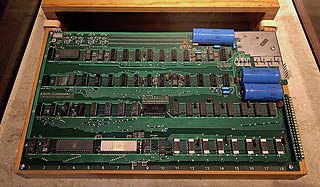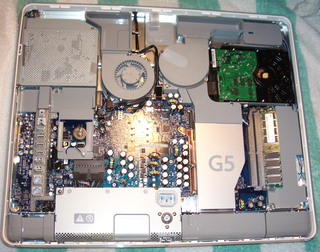 W
WAirPower is an unreleased wireless charging mat developed by Apple Inc. It was designed to charge up to three devices simultaneously, supporting two Qi devices, such as an iPhone and AirPods, and an Apple Watch. It was announced on September 12, 2017. Originally planned to be released in early 2018, AirPower failed to materialize, leading to wide speculation over the product's future, until Apple announced on March 29, 2019 it had cancelled the release.
 W
WThe Apple Display Connector (ADC) is a proprietary modification of the DVI connector that combines analog and digital video signals, USB, and power all in one cable. It was used in later versions of the Apple Studio Display, including the final 17" CRT model, and most versions of the widescreen Apple Cinema Display, after which Apple adopted standard DVI connectors on later models.
 W
WFileWare floppy disk drives and diskettes were designed by Apple Computer as a higher-performance alternative to the Disk II and Disk III floppy systems used on the Apple II and Apple III personal computers. The drives are also referred to as Apple 871 drives in service documentation, based on their approximate formatted storage capacity in kilobytes, but are most commonly known by their code name, Twiggy, after the famously thin 1960s fashion model.
 W
WThe Apple Computer 1, originally released as the Apple Computer and known later as the Apple I, or Apple-1, is a desktop computer released by the Apple Computer Company in 1976. It was designed and hand-built by Steve Wozniak. The idea of selling the computer came from Wozniak's friend Steve Jobs. The Apple I was Apple's first product, and to finance its creation, Jobs sold his only motorized means of transportation, a VW Microbus, for a few hundred dollars, and Wozniak sold his HP-65 calculator for $500. Wozniak demonstrated the first prototype in July 1976 at the Homebrew Computer Club in Palo Alto, California.
 W
WThe Apple Interactive Television Box (AITB) is a television set-top box developed by Apple Computer in partnership with a number of global telecommunications firms, including British Telecom and Belgacom. Prototypes of the unit were deployed at large test markets in parts of the United States and Europe in 1994 and 1995, but the product was canceled shortly thereafter, and was never mass-produced or marketed.
 W
WThe Apple Keyboard is a keyboard designed by Apple Inc. first for the Apple line, then the Macintosh line of computers. Dozens of models have been released over time, including the Apple Extended Keyboard. Currently, Apple offers only three keyboards via Bluetooth: Magic Keyboard, and Magic Keyboard with Numeric Keypad. A black and silver model is also included with the Mac Pro.
 W
WLisa is a desktop computer developed by Apple, released on January 19, 1983. It is one of the first personal computers to present a graphical user interface (GUI) in a machine aimed at individual business users. Development of the Lisa began in 1978, and it underwent many changes during the development period before shipping at US$9,995 with a five-megabyte hard drive. The Lisa was challenged by a relatively high price, insufficient software library, unreliable Apple FileWare ("Twiggy") floppy disks, and the immediate release of the cheaper and faster Macintosh — yielding lifelong sales of only 10,000 units in two years.
 W
WThe Apple QuickTake is one of the first consumer digital camera lines. It was launched in 1994 by Apple Computer and was marketed for three years before being discontinued in 1997. Three models of the product were built including the 100 and 150, both built by Kodak; and the 200, built by Fujifilm. The QuickTake cameras had a resolution of 640 x 480 pixels maximum.
 W
WApple TV is a digital media player and microconsole developed and sold by Apple Inc. It is a small network appliance and entertainment device that can receive digital data for visual and audio content such as music, video, video games, or the screen display of certain other devices, and play it on a connected television set or other video display.
 W
WApple Watch is a line of smartwatches produced by Apple Inc. It incorporates fitness tracking, health-oriented capabilities, and wireless telecommunication, and integrates with iOS and other Apple products and services.
 W
WThe Apple Watch Series 4 is a smartwatch by Apple Inc.. It was released during the 2018 Apple Special Event held at the Steve Jobs Theater in California. It has received mostly positive reviews from critics.
 W
WForce Touch is a Haptic technology developed by Apple Inc. that enables trackpads and touchscreens to distinguish between various levels of force being applied to their surfaces. It uses pressure sensors to add another method of input to Apple's devices. The technology was first unveiled on September 9, 2014, during the introduction of Apple Watch. Starting with the Apple Watch, Force Touch has been incorporated into many products within Apple's lineup. This notably includes MacBooks and the Magic Trackpad 2. The technology is known as 3D Touch on the iPhone models. The technology brings usability enhancements to the software by offering a third dimension to accept input. Accessing shortcuts, previewing details, drawing art and system wide features enable users to additionally interact with the displayed content by applying force on the input surface.
 W
WHomePod is a smart speaker developed by Apple Inc. The HomePod is designed to work with the Apple Music subscription service. It is sold alongside the smaller and lower-priced HomePod Mini.
 W
WThe HomePod Mini is a smart speaker developed by Apple Inc. Roughly spherical, it is smaller and less expensive than Apple's similar HomePod.
 W
WThe Integrated Woz Machine is a single-chip version of the floppy disk controller for the Apple II. It was also employed in Macintosh computers.
 W
WiPad is a line of tablet computers designed, developed and marketed by Apple Inc., which run the iOS and iPadOS mobile operating systems. The first iPad was released on April 3, 2010; the most recent iPad models are the eighth-generation iPad, released on September 18, 2020; the fifth-generation iPad mini, released on March 18, 2019; the fourth-generation iPad Air, released on October 23, 2020; and the second-generation 11-inch (280 mm) and fourth-generation 12.9-inch (330 mm) iPad Pro, released on March 25, 2020.
 W
WThe iPod is a line of portable media players and multi-purpose pocket computers designed and marketed by Apple Inc. The first version was released on October 23, 2001, about 8 1⁄2 months after the Macintosh version of iTunes was released. As of May 28, 2019, only the iPod Touch remains in production.
 W
WLightning is a proprietary computer bus and power connector created and designed by Apple Inc. Introduced on September 12, 2012, to replace its predecessor, the 30-pin dock connector, the Lightning connector is used to connect Apple mobile devices like iPhones, iPads, and iPods to host computers, external monitors, cameras, USB battery chargers, and other peripherals. Using 8 pins instead of 30, Lightning is more dense than its predecessor, which was integrated with devices like the iPhone 4 and the iPad 2. The male Lightning connector is symmetrical, so it can be inserted into a female Lightning port in either orientation.
 W
WLocalTalk is a particular implementation of the physical layer of the AppleTalk networking system from Apple Computer.
 W
WHardware of the Macintosh is produced solely by Apple Inc., who determines internal systems, designs, and prices. Apple directly sub-contracts hardware production to external OEM companies, maintaining a high degree of control over the end product. Apple buys certain components wholesale from third-party manufacturers. The current Mac product family uses Intel x86-64 processors, however it is moving to Apple-designed processors until 2022. All Mac models ship with at least 8 GB RAM as standard. Current Mac computers use AMD Radeon or integrated graphics. Macs include two standard data transfer ports: USB and Thunderbolt. USB was introduced in the 1998 iMac G3 and is ubiquitous today; Thunderbolt is intended for high-performance devices such as external graphics cards.
 W
WMagSafe was a series of proprietary magnetically attached power connectors for Mac laptops introduced by Apple Inc. It was introduced on January 10, 2006 in conjunction with the MacBook Pro, the first Intel-based Mac laptop, at the Macworld Expo. The connector is held in place magnetically so that if it is tugged — for example, by someone tripping over the cord — it will pull out of the socket without damaging the connector or the computer power socket, and without pulling the computer off of its surface. A thinner and wider version, called MagSafe 2, was introduced in 2012. Despite its popularity with many users, it was discontinued across Apple's product lines between 2016 and 2019 and replaced with USB-C.
 W
WThe Mini DisplayPort is a miniaturized version of the DisplayPort audio-visual digital interface.
 W
WThe Mini-DVI connector is used on certain Apple computers as a digital alternative to the Mini-VGA connector. Its size is between the full-sized DVI and the tiny Micro-DVI. It is found on the 12-inch PowerBook G4, the Intel-based iMac, the MacBook Intel-based laptop, the Intel-based Xserve, the 2009 Mac mini, and some late model eMacs.
 W
WNuBus is a 32-bit parallel computer bus, originally developed at MIT and standardized in 1987 as a part of the NuMachine workstation project. The first complete implementation of the NuBus was done by Western Digital for their NuMachine, and for the Lisp Machines Inc. LMI Lambda. The NuBus was later incorporated in Lisp products by Texas Instruments (Explorer), and used as the main expansion bus by Apple Computer and a variant called NeXTBus was developed by NeXT. It is no longer widely used outside the embedded market.
 W
WThe Apple Bandai Pippin, stylized PiP P!N, is a multimedia technology console, designed by Apple Computer. The console is based on the Apple Pippin platform – a derivative of the Apple Macintosh platform. Bandai produced the ATMARK and @WORLD consoles between 1996 and 1997. It was sold at $599.
 W
WThe Apple Pippin is a defunct open multimedia technology platform, designed by Apple Computer, and marketed as PiPP!N. According to Apple, Pippin was directed at the home market as "an integral part of the consumer audiovisual, stereo, and television environment."
 W
WApple PowerCD is a CD player sold by Apple Computer in 1993 and discontinued several years later. It was a re-badged Philips-designed product which was sold in addition to Apple's speakers and also included a remote control. The PowerCD was capable of reading Kodak photo CDs, data CDs and audio CDs. It can connect to Apple Macintosh personal computers through SCSI and also to stereo systems and televisions.
 W
WThe Siri Remote is a remote control released by Apple with the Siri-capable fourth generation Apple TV. The Siri Remote is the successor to the original Apple Remote.
 W
WXserve is a line of rack unit computers designed by Apple Inc. for use as servers. Introduced in 2002, it was Apple's first designated server hardware design since the Apple Network Server in 1996. In the meantime, ordinary Power Macintosh G3 and G4 models were rebranded as Macintosh Server G3 and Macintosh Server G4 with some alterations to the hardware, such as added Gigabit Ethernet cards, UltraWide SCSI cards, extra large and fast hard drives etc. and shipped with Mac OS X Server software. The Xserve initially featured one or two PowerPC G4 processors, but later switched over to the then-new PowerPC G5, transitioned to Intel with the Core 2-based Xeon offerings and subsequently switched again to two quad-core Intel Nehalem microprocessors.